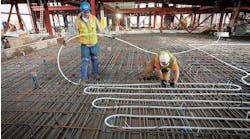Latest from Management
Sponsored
The next series of articles on alternative radiant heating systems is going to be directed towards radiant ceiling heating and cooling systems. In all of my years of applying radiant comfort systems, one area that has always been underutilized in my professional opinion, is the application of radiant ceilings. Not only is it extremely conducive to retrofit considerations, but it can also be utilized for delivery of base loading on a given dwellings cooling loads. Radiant cooling is going to be addressed in future articles due to the special handling required to avoid the possible production of condensation. More on radiant cooling later, so stay tuned.
In looking at the historic application of radiant ceilings, we find that it was actually more popular than radiant floors shortly after the turn of the last century. My first experience with it was in a home located on Capitol Hill in Denver. I was called in for an emergency service call to repair a hydronic heating system that had been inadvertently cut into in the process of getting some of those fancy new tubular skylights in a master bedroom suite. The homeowners had hired a contractor to install these reflective tube skylights into the ceiling of their master bedroom. The consumer knew that they had a radiant heating system in their home, which was built around 1912, but they thought it was radiant floors, and not radiant ceilings because their floors were never really very cold to the touch.
Lo and behold, as their building contractor began using his electric reciprocating saw to perform Sawzall surgery on their ceiling, water began pouring out of the ceiling like a Chinese sprinkler. In their mass panic effort to mitigate damage, the homeowners wisely shut off the main water supply going into their home. Their first response was to call a plumber, because they thought that they’d severed a plumbing line. Once the plumber showed up on the jobsite, he informed them that it was a heating system problem, and he was not licensed or insured to work on heating, so he referred them to our firm, which did work on hydronic radiant heating systems.
Upon arrival, I found a number of 3/8” copper tube that had been fastened to the wood lathe strips, and then covered with horse hair plaster. The tubes had been severed by the reciprocating saw’s blade. Repairs were easy enough, rerouting the tubes around the 14” hole that had been cut to receive the reflective solar tube. But the interesting thing was the response of the homeowner. He swore that he had radiant floors on not radiant ceilings because his floors were never cold. Bear in mind this installation was done in the early 1900s, and the critical placement of insulation was unknown at that point in time. It is entirely possible that the radiant ceiling heating system serving the main floor level was causing the second level’s floor to feel rather warm. In fact, the homeowner wanted to know if there was any way to lower the operating temperature of the second floor living spaces. This situation is what I call a “radiant sandwich.” Due to the missing insulation in the ceiling of the main level, and the installation of the radiant ceiling on the second level, when the occupants were on the second level, they were being heated from the ceiling and the floor. I recommended he contact an associate of mine and get the ceiling joist cavity of the main floor insulated with blown in cellulose insulation to control the directional flow of heat. It was an interesting study of early hydronic based radiant comfort systems to say the least. I did have occasion to speak with the homeowners a couple of years after I’d performed the emergency service call to gauge their comfort levels. The owners said that the bedrooms on the second level had become much less overheated and that they were still elated with the overall comfort conditions of their home. They said that they were more aware of the fact that the ceiling was emitting heat, but that overall, it was still significantly more comfortable than any other dwelling they’d lived in. This piqued my interest in radiant ceilings. I began doing my own research and personal surveys of customer who were requesting radiant floor heating systems and I gathered some interesting information that I will share with you in the next few articles.
Tune in next month as we continue looking at alternative radiant heating surfaces in our efforts to “Grow Radiant.” If you have not yet become a member of the new RPA, by all means go to our website at www.radiantprofessionalsalliance.org and get signed up. It is an inexpensive way to support your industry, which is here to support you!
All Mark Eatherton material on this website is protected by Copyright 2013. Any reuse of this material (print or electronic) must first have the expressed written permission of Mark Eatherton and CONTRACTOR Magazine. Please contact via email at: [email protected].
Mark Eatherton
Mark Eatherton material on this website is protected by Copyright 2017. Any reuse of this material (print or electronic) must first have the expressed written permission of Mark Eatherton and CONTRACTOR Magazine.

